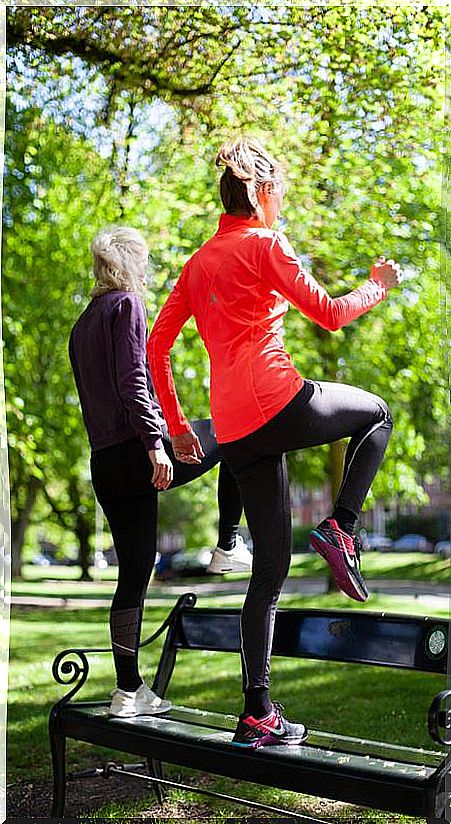Benefits Of Exercising For The Brain (and Memory)
Exercising is not just about moving your muscles. Neuroscience has shown that this healthy habit, in the long run, improves memory, drives away dementia, activates creativity and supports mental health.

Neuroscience has confirmed the great benefits of physical exercise (adapted to age and personal lifestyle) on health. But what is the excellence of physical exercise? Possibly, that its benefits are not exclusive for the proper functioning of our body (cardiovascular system, joints and muscles) but, among others, also for the mind, since it contributes to improving attention and memory.
The benefits of physical exercise for memory are such that there is even a trend, neuroeducation, which proposes scheduling physical activities in schools from mid-morning to facilitate the memorization of the knowledge worked during the first hours. As simple as that. Neuroscience explains why this relationship.
Cognitive training or physical exercise?
You may ask yourself the following question: if I want to improve my cognitive functions, wouldn’t it be better to exclusively use memory and attention tests specifically designed for this?
In this sense, Sandra Chapman, a professor at the University of Dallas (Texas) who investigated and compared the benefits of both training sessions (mental and physical) concluded that physical exercise influenced memory more while cognitive specific training did so on memory. abstract reasoning.
Why moving your muscles activates your memory
Physical exercise stimulates the production of various substances in skeletal muscle. For example, neurotrophins or “brain derived neurotrophic factors” (Brain Derived Neurotrophic Factor), proteins that promote the survival of neurons and act positively on memory.
These substances activate vascularization, favoring the supply of glucose and oxygen, essential nutrients for neurons, affect neurogenesis or the creation of new neurons in the hippocampus, a fundamental area for memory (Pereira et al. 2007), ultimately contributing , to better brain function.
Of course, it is not an immediate effect. A minimum of 20 minutes of physical activity is required, time that the organism needs to obtain the necessary energy from fats, once the carbohydrates have been metabolized. It is then that irisin is secreted, an essential enzyme for the synthesis of BDNF proteins.
Skeletal muscle is no longer simply a contractile organ for the sole purpose of generating movement, but a highly active endocrine element.
During exercise they secrete molecules that are beneficial to the body and brain.
These molecules include hormones (myokines), growth factors, and proteins (cytokines) that are critical for cell signaling. In this way, there is a communication between the muscle and other distant tissues or organs, with a variety of effects (anti-inflammatory, fat metabolizing, among others) promoting health and well-being.
Exercise repetitions protect your neurons
If we combine physical exercise with adequate social interaction and certain intellectual activity, we will have powerful tools to delay dementias, improving the quality of life. This is what epidemiological studies indicate, in the words of neuroscientist Arthur Kramer, an expert in physical exercise and aging.
Like any other repetitive activity, it produces structural changes in the brain. Thus, it has been observed that physical exercise increases the volumes of the hippocampus and the prefrontal cortex, two of the areas specifically sensitive to neurodegeneration.
Your mind becomes more creative if you do sports
Not only does your memory improve when you exercise, your creativity also benefits. Are you working on your final degree project (TFG) or master’s degree (TFG) and have you pigeonholed yourself? Do not give it more laps. Put on some sneakers and, without thinking about anything in particular, take a few laps. You will be surprised at the ideas that will come to your mind helping you to move forward with the project.
Physical exercise, especially endurance, is a space for creativity for the brain. It is in those moments when apparently no intellectual activity takes place that the default neural network, discovered by Marcus Raichle in 2001, is activated and is responsible for the sparkling “eureka” moments.
Other benefits for your mind
There is no doubt that physical activity and brain go hand in hand: it influences our mood, affects learning, attention, improves anxiety, stress and can even help us to immunize ourselves against some diseases or, at least, alleviate them .
Physical exercise, in addition to providing more oxygen to the brain, increases the levels of certain neurotransmitters (serotonin, dopamine, norepinephrine) and endogenous opioids (endorphins), which contribute to a pleasant feeling of well-being. Something difficult to understand for those who are sedentary. How can someone who is “crushing” and perspiring sweat experience well-being?
Joggers know from experience the “pleasure” they feel, how their mood improves after training, and the emotional balance they experience. That is why it is highly recommended as therapy in cases of addiction and depression.
Do not hesitate, incorporate physical activity into your daily routine. “Run a few miles on the treadmill and you will not improve your depression but you will live longer,” scientists often advise about it. Your body and your brain will thank you.
Start moving (through your body and through your brain)
When there is no clear and decisive motivation to incorporate a daily period of time to physical activity, it becomes a great sacrifice. The perfect excuse is, then, the lack of time for work and domestic tasks. Therefore, we need to find a motivation to adopt this healthy habit: if taking care of your body does not motivate you, it may help you to think about all the benefits that exercise could have for your mind.
There is a little (great) trick to encourage the start of physical activity because for newbies it is still boring, tiring, and even for those already used to it, there is always that day when there is no desire but we know we have to do it . It’s about incorporating music into training.
Without realizing it, you will be moving and your muscles will secrete all those molecules that are so beneficial to health.
Listening to your favorite songs, one after the other, with your playlist on your mobile, those 30 minutes a day will no longer be a sacrifice, but a pleasure. By adapting your movements to the musical rhythm, the oxygen consumption will be lower and the fatigue and feeling of effort will decrease.
The synergy of music with movement produces even greater benefits than just physical exercise. For example, in studies with older people, they are found to improve grip strength by exercising when listening to music (Den Elzen, 2019) compared to without it.









